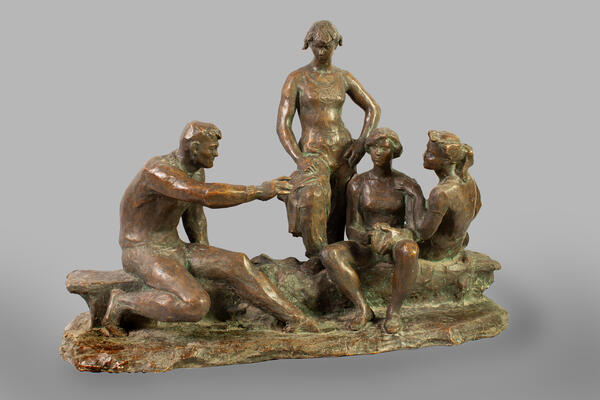The Tambov Art Gallery houses the sculptural group “At the Stadium”, created by the Soviet and Russian sculptor Margarita Mikhailovna Voskresenskaya (1931–2012).
Margarita Voskresenskaya was born in Moscow in 1931. A half-starved war-time childhood and a difficult post-war youth had a great influence on the formation of her personality.
In 1954, she graduated from the department of monumental and decorative sculpture at the Moscow Institute for the Industrial and Applied Arts, and in 1957 she completed her postgraduate studies in the same department. The first works of Margarita Voskresenskaya were not considered an unexpected discovery, and neither did they provoke any fierce disputes between critics and colleagues. The works were original to some extent but at the same time fit perfectly into the system of aesthetic ideals of the 1950s. However, over time, Voskresenskaya’s sculpture began to acquire more significance and individual traits. It took her years to overcome the difficulties unrelated to the creative process (lack of a proper workshop and contracts), which forced Margarita Voskresenskaya, who was a monumentalist, to work in small-scale sculpture. And yet, since 1955, Voskresenskaya was a regular participant in Moscow, republican, all-Union, and then foreign exhibitions. In 1961, together with Mikhail Smirnov, she organized her first exhibition in Moscow (in the hall on Begovaya Street), which included not only plaster works, but also wooden, galvanoplastic, and marble ones. Subsequently, the sculptor’s works were exhibited in Austria, the Federal Republic of Germany, Poland, Romania, Canada, and other countries. Voskresenskaya achieved great success at the exhibition “Russian Tree” in Paris and the Fifth Baltic Biennial in Rostock. In 1973, Margarita Voskresenskaya won the prize at the second International Small Sculpture Biennale in Budapest.
In the displayed work “At the Stadium”, Voskresenskaya explores the theme of sports. Her images, despite being quite generalized and solid, are well modeled and organized. The sculptor tries to reveal the individuality of each character through their postures, facial expressions, and gestures.
Margarita Voskresenskaya was born in Moscow in 1931. A half-starved war-time childhood and a difficult post-war youth had a great influence on the formation of her personality.
In 1954, she graduated from the department of monumental and decorative sculpture at the Moscow Institute for the Industrial and Applied Arts, and in 1957 she completed her postgraduate studies in the same department. The first works of Margarita Voskresenskaya were not considered an unexpected discovery, and neither did they provoke any fierce disputes between critics and colleagues. The works were original to some extent but at the same time fit perfectly into the system of aesthetic ideals of the 1950s. However, over time, Voskresenskaya’s sculpture began to acquire more significance and individual traits. It took her years to overcome the difficulties unrelated to the creative process (lack of a proper workshop and contracts), which forced Margarita Voskresenskaya, who was a monumentalist, to work in small-scale sculpture. And yet, since 1955, Voskresenskaya was a regular participant in Moscow, republican, all-Union, and then foreign exhibitions. In 1961, together with Mikhail Smirnov, she organized her first exhibition in Moscow (in the hall on Begovaya Street), which included not only plaster works, but also wooden, galvanoplastic, and marble ones. Subsequently, the sculptor’s works were exhibited in Austria, the Federal Republic of Germany, Poland, Romania, Canada, and other countries. Voskresenskaya achieved great success at the exhibition “Russian Tree” in Paris and the Fifth Baltic Biennial in Rostock. In 1973, Margarita Voskresenskaya won the prize at the second International Small Sculpture Biennale in Budapest.
In the displayed work “At the Stadium”, Voskresenskaya explores the theme of sports. Her images, despite being quite generalized and solid, are well modeled and organized. The sculptor tries to reveal the individuality of each character through their postures, facial expressions, and gestures.



